The mobile market is continuing to dominate advertiser’s attention and their need to conform their marketing efforts to mobile users.
Ranking #1 in Google has a 23.5% mobile clickthrough rate, down from 28.6% in 2015 – Advanced Web Ranking (2017)
It seems as though Google’s introduction of 4 ads in search results has impacted mobile quite a bit. More so than desktop, by a lot.
Mobile CTR for the #1 Position on desktop in 2017 is 29.2%. #1 Position in 2015 was 27.0%. So, a substantial drop in 2 years time, but not nearly as big as mobile dropping from 28.6% to a 23.5% click through rate.
Learn more about click through rates and how to improve them here.
48% start mobile research from search engines – Smart Insights (2017)
What’s interesting is the fact that so many mobile users DON’T start their research using search engines. 33% go directly to the site they want, while 26% being in an app.
……says the search engine marketer.
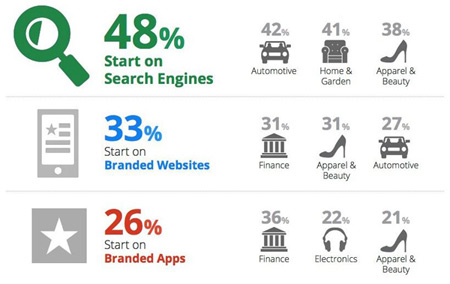
New Statistic (updated 9/4/17)
Google drives 96% of mobile search traffic, followed by Yahoo at 2% and Bing at 1% NetMarketShare (2017)
Google dominates when it comes to mobile search. And obviously, they’re the top dog when it comes to desktop search as well. But only with a mere 81% search engine market share.
Google’s 96% share is up from 94% (2016).
Google holds a 95% share in mobile paid search ad clicks – Merkle (2016)
According to the report, “This influx of mobile ad volume is driving average cost per click (CPC) lower and cannibalizing organic search visits, but it is ultimately propelling Google search spending to a six-quarter high.”.
MOBILE SEARCH: LOCAL & LOCATION-TARGETED ADS
Mobile searches with local intent are on the rise, and advertisers are putting more money into things like location-targeted ads to capitalize on the trend.
Local searches are growing 50% faster than mobile searches overall – Search Engine Land (2016)
According to Google, a third of mobile searches are local. And that local searches on mobile devices are growing 50% faster than mobile searches as a whole.
This is likely true. And likely the reason Google has begun putting more emphasis on local map ads in search, especially important for local search advertisers.
Location-targeted mobile ad spend will grow from $12.4 billion in 2016 to $32.4 billion in 2021 – BIA/Kelsey (2017)
Location-based ads include those targeting users in a given location, and/or targeting users searching with local intent (i.e. “plumber dallas tx“).
It’s difficult to see search engine results by location since Google removed this feature. But there are still multiple solutions out there to view SERPs by geo-target location.
Mobile is one of the fastest growing areas for geo-targeted media. Advertisers are seeing great return with location-targeted ads on mobile devices. In the years to come, half of all ads may well be location-targeted.
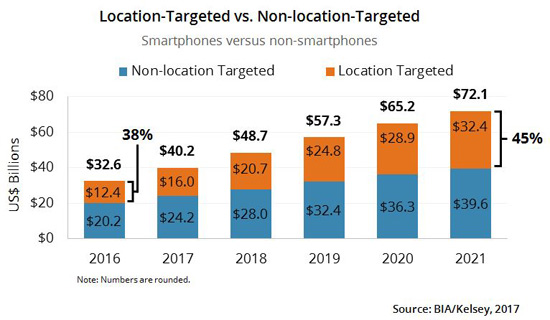
MOBILE PAGE LOAD SPEED, AMPS, & AFFECT ON TRAFFIC
Page Load Speed is essentially the amount of time it takes for a web page to fully load. And in mobile, pages will typically take even longer to load.
I actually just found this nifty little tool, while writing this. Assuming you trust Google’s statistics, check out the effect mobile speed can have on your ad revenue.
Google’s Accelerated Mobile Pages (AMP) make up 7% of traffic to US publishers – Adobe Analytics (2017)
Google’s Accelerated Mobile Pages (or AMPs), introduced in October 2015, are meant to deliver lightning-fast web browsing. By serving pages through their own servers, Google is able to load content from search results with amazing speed.
For those not familiar, AMP pages are something you have to create yourself. Basically, they are an alternate version of your web pages that conform to the AMP Project specifications.
What’s the return?
Well, for the most part AMPs have shown promise – the amount of AMPs on the web have grown 405%, and the Washington Post seems to have increased return visitors by 23% thanks to AMPs.
BUT, there’s always another side to the story. According to the Wall Street Journal, “Multiple publishers said an AMP pageview currently generates around half as much revenue as a pageview on their full mobile websites.”
So who knows. The Amp Project is still in its infancy, so only time will tell.
Avg. pageload speed on mobile sites is 22 seconds – Think With Google (2017)
It was years ago that Google told us page load speed was a search ranking factor. And, more recently, Google confirmed that mobile page load speed will be a mobile search ranking factor.
Regardless, don’t you want to show consumers what it is you’re offering? Why, with the needless friction? Fix it!
53% of mobile pages are abandoned if longer than 3 seconds to load – DoubleClick (2016)
I will admit to doing this. If I’m on my phone, and click on something in the search results that I think is exactly what I’m looking for……. and there’s like, any noticeable delay at all…. I immediately hit the back button and say “Nope. Sorry”. I promise, I actually say that, out loud.
A 10 second page load time has a 123% higher bounce rate than a 1 second page load time – Think With Google (2017)
Bounce rate is the rate at which a user first lands on a website and leaves without visiting another page. So if a user clicks on a web page from the search results, they’re far more likely to bounce, if the page is taking far too long to load.
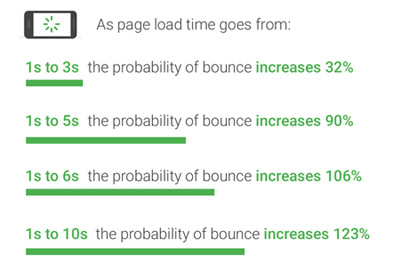
MOBILE-FRIENDLY DESIGN STATS
The mobile trend is no longer a trend, but rather a movement. Whether your company is service-based, e-commerce, B2B, it doesn’t matter. It’s imperative that your website is completely mobile-friendly.
Don’t believe me? Just check the stats below.
Users are 5x more likely to leave a site that is not mobile friendly – Google Small Business (2016)
And when I say “mobile-friendly”, I’m talking about a completely functional responsive site design. Responsive, as opposed to a mobile version of a site that delivers different URLs on mobile (i.e. m.flickr.com).
Mobile versions tend to have a far worse user experience than if the site were responsive or if the site is designed solely for desktop.
You can get a good idea of how mobile-friendly your site is with Google’s tool here. If you want to go one step beyond, then I suggest heading on over to Screenfly to check your pages responsiveness on all devices and screen resolutions.
A completely responsive web design will allow the content on your blog, and the rest of your site to adapt to all devices and screen resolutions (sizes). Responsive is meant to improve functionality and readability of content on mobile, tablet, or desktop.
And guess what? Mobile-friendly is an SEO ranking factor, which Google first announced back in 2015.
In Social Media Examiner’s 2016 survey, 54% of marketers say their blog is optimized for mobile. This is up from 50% in 2015, and 43% in 2014.
MOBILE USAGE, INTERNET, & WEB TRAFFIC STATISTICS
At a global scale, smartphone usage is exploding. And not just in the U.S. and North America. The massive shift to smartphones is occurring in most markets worldwide.
What’s the Global Device of Choice?
Those running on the Android operating system. 86% of smartphones sold worldwide are powered by Android, vs 13% running on Apple’s iOS.
New Statistic (updated 4/1/17)
69% of digital media time is spent on mobile – comScore (2017)
comScore’s new report (“2017 US Cross-Platform Future in Focus“) reveals digital media consumption is growing, and that nearly 70% is from mobile usage. Not terribly surprising, but another fact to help reiterate mobile’s dominance.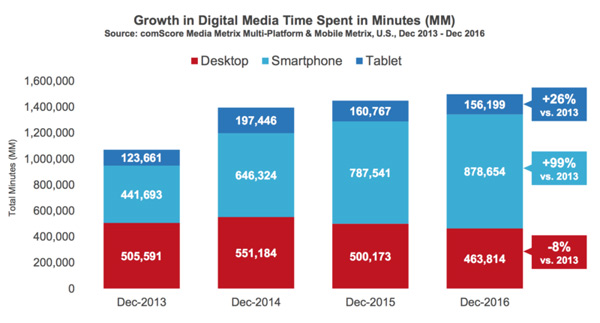
Over 8 in 10 internet users will use a smartphone to access the web regularly in 2017 – eMarketer (2017)
The amount of U.S. desktop/laptop only internet users is dwindling — down from 25 million in 2015, to 18 million people in 2017. And expected to be down to 11 million desktop-only users by 2021.
Meanwhile, Mobile-only internet users have grown 28% in the last two years alone, at 41 million U.S. in 2017.
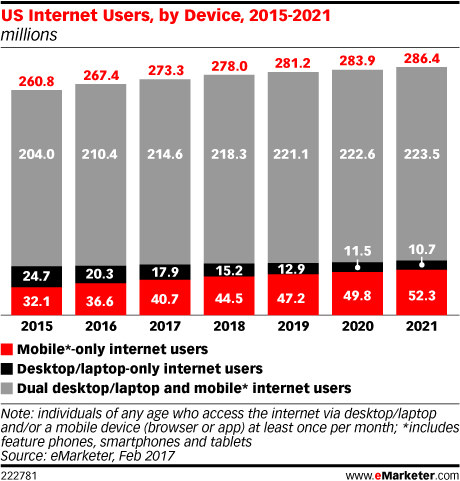
77% of Americans own a smart phone, up from 35% in 2011 – Pew Research (2017)
This is a cool statistic. But honestly, I’m surprised smart phones haven’t eclipsed 90% in America yet.
More than half of all web traffic comes from mobile or tablet – Stat Counter (2016)
In October, 2016, global internet usage finally became mobile, with mobile/tablet eclipsing desktop 51.3% to 48.7%.
New Statistic (updated 9/20/17)
August, 2017 – Mobile/tablet global internet usage now at 57.3%, vs desktop at 42.7%. (Stat Counter)
This is why one of the first things we look at with new clients is how mobile-friendly the site truly is.
Make sure at the very least you’ve checked the following:
- Mobile pageload speed
- Googlebot rendering
- User-Experience (UX) metrics in Google Analytics
- Clear calls to action on mobile
- Functionality on mobile
- Element sizing for different resolutions
- Content overlap
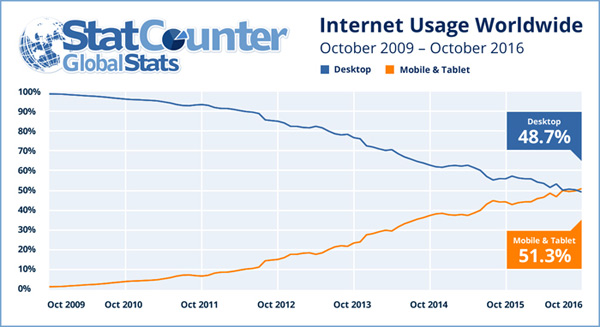
68% check their phone within 15 minutes of waking up – Google Micro-Moments (2015)
30% even admit getting “anxious” when they don’t have their phone with them.
US consumers spend 5 hrs a day on mobile devices – Flurry Mobile (2016)
Facebook and Facebook-owned Instagram and WhatsApp dominate the highest share with 19% of those 5 hours.

MOBILE SOCIAL MEDIA USAGE (SOCIAL APP STATISTICS)
Millennials are goin nuts y’all!
Right?
Easy there. My fellow Millennials and I do indeed spend our fair share of time Facebooking and Instagramming on our smartphones. BUT, would you believe that Generation X is more addicted to social media than us Millennials? Eat that Obama!
At any rate, it’s clear that social media and social networking usage on mobile is big. And it’s still on the rise.
80% of social media time is spent on a mobile device – comScore (2016)
Mobile dominates when it comes to social media. And Facebook dominates when it comes to social media on mobile.
Top 10 Social Media Apps (March, 2017): From the data at SimilarWeb, I took the top Google Play Apps based on SimilarWeb’s Usage Ranking.
1.15 billion of Facebooks 1.23 billion daily active users are mobile – Facebook (2017)
By tapping into this massive audience, marketers can improve brand awareness, generate targeted leads, promote a new product, and the list goes on.
The main advantage of Facebook advertising (aside from its reach) is segmentation. You can segment your ad reach to hit the perfect target audience.
82% of Twitter users are accessing from their mobile device – Venture Beat (2016)
And just for fun, here are the Top 3 most popular tweets of 2016!
M-COMMERCE (MOBILE SHOPPING STATS)
If you sell stuff online, mobile e-commerce is important to you. Check out our guide on Ecommerce (and m-commerce) SEO to learn more about increasing traffic and conversions to product pages.
78% of consumers made a purchase on their mobile device in 2016 – The Financial Brand (2017)
It’s taken a few years, but we’re now at the point where most people are comfortable buying online. And now that more websites are mobile-friendly, and with app development and usage on the rise, users have decided they’re more than comfortable shopping on their smartphone.
36% purchased a physical product. And 33% made a payment using a mobile app, up from 16% from 2 years prior (2014).
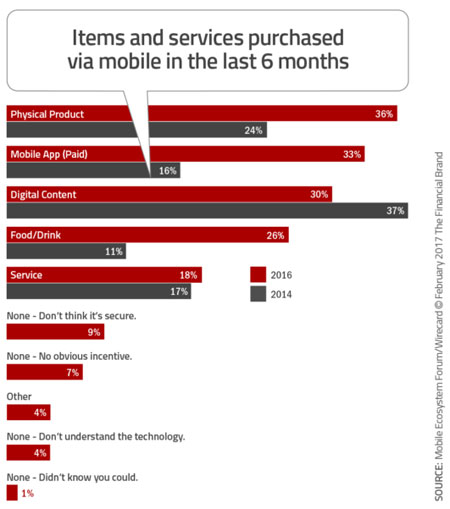
Mobile makes up 21% of online spending – comScore (2017)
Data outlined in comScore’s M-Commerce Report is from Q4, 2016, so super recent. And from a marketing perspective, the data is even more relevant, as this includes holiday purchasing.
Of the $109.3 billion spent online in Q4, $22.7 billion (21%) was on mobile. This is up from a mere 4% in 2010. So going from that to now 21%, it’s safe to say that at some point in the near future, mobile will surpass desktop in e-commerce purchases.

Shopping cart abandonment rate is 78% on mobile (vs 63% on desktop) – Barilliance (2016)
While spending on mobile is increasing, shopping cart abandonment is a great concern for mobile marketers.
That said, here’s a positive takeaway for mobile marketing. According to the Barilliance report, “Retailers who retargeted users who abandoned their cart with shopping cart abandonment email saw conversions of 17.6% from these emails”.
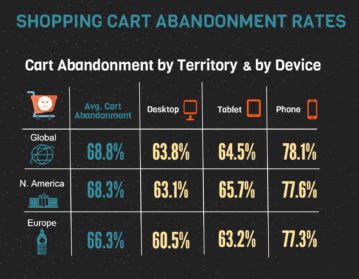
According to ventureburn.com, some of the friction points causing mobile cart abandonment include the following:
- A long checkout process
- Poor mobile design
- Pageload speed
- Registration forms
MOBILE ADVERTISING (OVERALL SPEND, FORECAST PROJECTIONS, & AFFECT ON CONSUMERS)
This section includes more general stats about mobile advertising, and numbers on mobile ad spend as a whole. You’ll find more specific mobile ad stats sprinkled throughout this article – like stats on Video ad spend, Native (In-App) ad spend, etc.
Worldwide, $143 billion will be spent on mobile ads in 2017 (twice that of 2015’s $71 billion) – Moinstall (2017)
A definite positive for mobile advertisers, especially those who’ve already been honing their mobile ad targeting skills.
However, I still feel as though mobile advertisers are behind this trend a bit. For example, oftentimes in our paid search for clients, we take over an existing ad campaign account. And it still boggles my mind that many don’t even have bid adjustments set up, mobile vs desktop.
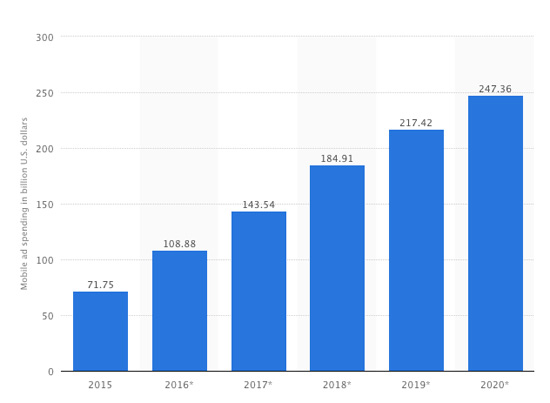
New Statistic (updated 9/20/17)
Mobile video ad spend grew 142% in Q2 2017 – Smaato (2017)
According to Smaato’s Global Trends in Mobile Advertising Q2 2017 report, video was the fastest growing mobile ad format in Q2 2017, as video mobile ad spending more than doubled (+142%) in one quarter alone.
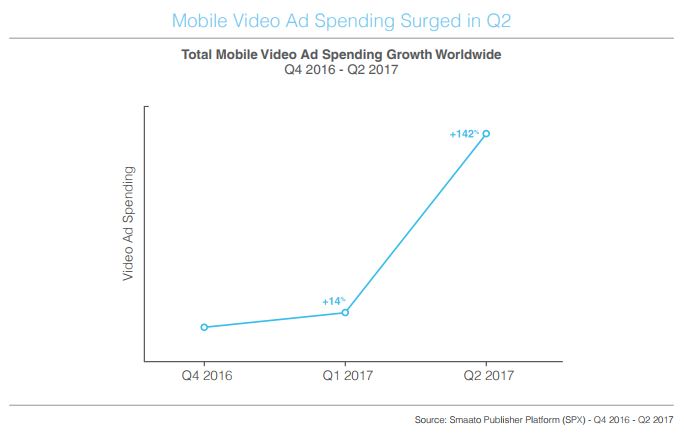
U.S. mobile ad spend will grow from $33 billion in 2016 to $72 billion by 2021 – BIA/Kelsea (2017)
No doubt, the sheer volume of U.S. smartphone usage is driving the increased spend in mobile. And smart digital marketers are seeing great return by focusing more of their efforts on mobile advertising.
$0.55 of every $1 spent on mobile advertising is wasted – Forrester (2016)
Forrester’s study found that only 27% mobile ads resulted in a positive response, and estimates that 55% of mobile ad spend is wasted.
Uh oh…
70% of people dislike mobile ads – HubSpot (2016)
The thing is, if a large percentage of your target audience dislike your ads, you’re doing it wrong. You’re throwing away money, and you’re pissing people off, likely hurting your brand, and you probably don’t even realize it.
I stumbled across a great article by Vieo Design, which details why people hate ads. I highly recommend reviewing this! Emily Winsauer sums it up well with “People feel overwhelmed, interrupted, and stalked by bad digital ads, but they don’t really mind the good ones.”

Mobile ad blocking has increased 90% year-over-year – PageFair (2016)
Adblocking has gone mobile. And to great scale. According to PageFair’s report, 2015 showed a 90% increase (Year over Year) in mobile ad blocking for web and in-app advertisements.
Globally, 419 million smartphone users utilize ad blocking tools, comprising 21% of the 1.9 billion smartphone users overall.
MOBILE VIDEO MARKETING & VIDEO CONSUMPTION
Video advertising is all the rage. And video traffic on mobile specifically, is projected to grow 50% every year through 2022. So expect to hear more about mobile video marketing in the months and years to come.
Video ad spend will see double-digit growth every year through 2020 – eMarketer (2016)
Technically, this statistic isn’t specific to mobile. But since video is on the rise with mobile, it’s more than relevant.
And, according to Ericsson’s Q3 2016 Mobility Report, mobile video traffic will see 50% growth every year through 2022.
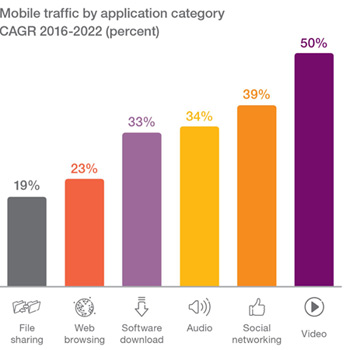
92% of consumers share mobile videos with others – HubSpot (2016)
And if you can get creative, you can generate a huge reach with your video. Like this clever video ad about mortgage bailouts, with a lady dancing in the background inside of what appears to be a static photo. This video ad from Lower My Bills generated 3.4 million views as of this post.
YouTube videos on mobile have a greater reach than TV, even during prime-time hours – Think With Google (2016)
Caveat: The stat goes, “YouTube reaches more 18-49 year olds during prime time than the top 10 network shows combined.”
So take with a grain of salt. This statistic comes directly from Google, and is definitely being used to kick’em while they’re down — tv that is.
Caveat #2: Stat was introduced during YouTube’s annual pitch to advertisers, known as Brandcast. Ben Popper of The Verge writes “Those numbers are a bit vague. We don’t know exactly how many people are watching, or whether any individual channel comes close to matching the reach of network TV programming.”
Regardless, we can all agree, YouTube has a shit-ton of viewers.
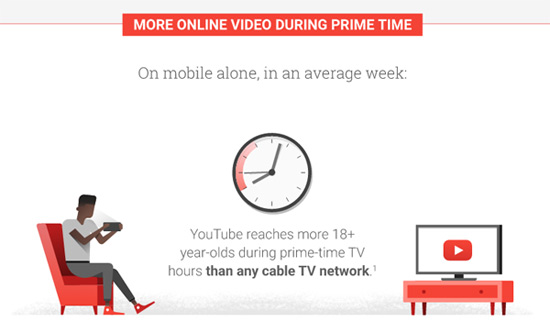
MOBILE EMAIL STATISTICS
Email marketing has come a long way since Hotmail was introduced back in 1996, the first web-based email service. I think I still have a hotmail account somewhere out there.
Mobile has altered the landscape for email marketing. Users prefer email with a responsive design. Email is one area in mobile marketing where I’m seeing a large marketing lag behind consumption growth.
56% of email is opened on mobile – Litmus (2016)
This was April of 2016, where Litmus reported a record-breaking 56% of email opened in mobile. This is an 8% increase in mobile email opens Year over Year.
Emails with a responsive design get 24% more clicks on mobile – YesMail (2015)
I was trying not to add a stat from before 2016, but this is the most recent data I could find. However, Yesmail’s email marketing report uses data from Q4 of 2015, so not terribly distant.
Yesmail’s mobile email report states that “Brands that have fully embraced responsive design see 24% more clicks coming from mobile than those that have not employed responsive design”.
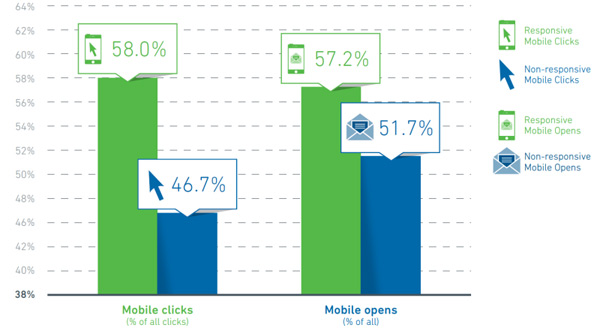
But only 17% of marketers are using responsive design in their emails – YesMail (2015)
Sounds to me like a good opportunity for email marketers. For those interested, here’s an extensive guide on responsive design for email.
APP USAGE & ADVERTISING, & NATIVE (IN-APP) ADS
In-app ads are one of the fastest growing forms of mobile advertising. More brands and agencies are noticing the disparity between the time people are spending in apps versus the allocation of ad spend in this medium.
900 billion hours were spent in apps worldwide in 2016 – App Annie (2017)
This is 150 billion hours more than the previous year. And if you’re thinking it’s all from gaming apps, think again.
App Annie’s report shows that non-gaming apps (i.e. banking and shopping apps) contributed more to the growth than gaming apps did.
86% of smartphone users time is spent in apps (14% in browser) – eMarketer (2016)
When it comes to the % of smartphone time spent in apps, Americans spend 86% in apps, and 14% in web browsers.
And here’s a look at the top 5 most used iOS apps, courtesy of Moment.

5 out of 10 apps are only used 10 times – Adobe (2016)
And over 20% of the time an app is used only once.
Why?
Because it was “not useful”, as reported by Adobe, for all age groups as the top reason for deleting an app. Adobe’s report says successful “apps must be useful, usable, and best-in-class”.
Native (In-App) Ads will make up 63% of mobile display advertising by 2020 – IHS (2016)
This would make up $53.4 billion in advertising spend.
General Mobile Usage Statistics:
- Mobile has overtaken desktop as main way to access the internet (Source: Comscore)
- In 2008, mobile represented 12% of overall digital consumption. In 2015, it jumped to 51%. (Source: Smart Insights)
- The average adult spends 3:15 hours per day on their mobile phone (not including voice calls!). (Source: Geo Marketing)
- Apps account for 89% of mobile media time, with the other 11% spent on websites. (Source: Smart Insights)
- Smartphone users spend approximately 10 percent of their time — over 20 minutes per day — on mobile social media. (Source: Geo Marketing)
- 68% of mobile users are engaging with brands via apps (Source: Flurry Mobile)
- 85% of adults are internet users and 77% are smartphone users (Source: Pew Research Center)

Employee Mobile Usage Statistics:
- 60% of employees use apps for work-related activity (Source: Digital Strategy Consulting)
- 71% spend over two hours a week accessing company information on mobile (Source: Fierce Mobile IT)
- Almost 9 in 10 app users say that apps for work have changed their behavior as a business professional (Source: Digital Strategy Consulting)
- 70 percent of employees keep their phones “within eye contact” at work (Source: Career Builder)
- The average mobile worker works 240 hours a year longer than the general population. (Source: iPass)
- Over 36% of mobile subscribers use smart phones or tablets to read email and 34% of subscribers only use mobile devices to read emails. (Source: Informz)
- 59% of respondents think that their organisation has been too slow at delivering apps for the workforce (Source: Digital Strategy Consulting)
Mobile Trends Statistics:
1. As of March 2017, 80% of top Alexa websites were mobile adaptive. (Mobiforge)
This is pretty cut-and-dry. If you want your site to perform well, it needs to be optimized for mobile.
2. 51% of all digital ad budgets in 2016 were spent on mobile. (IAB/PricewaterhouseCoopers)
Marketers and advertisers are heavily investing in mobile, which means, most likely, so is your competition. If you want to stay competitive, you need to have a mobile optimization or marketing strategy in place.
3. By 2019, mobile advertising is expected to represent 72% of all U.S. digital ad spending. (MarketingLand)
But at the same time…
4. 70% of people report disliking mobile ads. (HubSpot)
In fact, mobile ad blocking has increased 90% year-over-year.
5. By 2018, American adults are expected to spend on average 3 hours and 23 minutes on nonvoice mobile media. (eMarketer)
That’s up more than 1 hour from 2013. It has increased steadily every year since.
6. 80% of internet users own a smartphone. (Smart Insights)
With so many cell phone services giving away free smartphones with their contracts, this number is only going to keep increasing — which is good news for companies with a mobile marketing strategy.
7. 48% of consumers start mobile research with a search engine –but 33% go directly to the site they want. (Smart Insights)
This is why you want to produce valuable content that makes it easy for your buyer persona to find you online. You also want to optimize for mobile search results.
8. Users spend on average 69% of their media time on smartphones. (comScore)
As a marketer, you need to align with the buyer’s behavior. With more than half of people consuming media via smartphones, you need to make sure yours offers the best experience possible.
9. Google drives 96% of mobile search traffic, followed by Yahoo at 2% and Bing at 1%. (NetMarketShare)
Google doesn’t just dominate search on desktop, but mobile as well. If you want to increase your mobile search traffic, optimize for Google on smaller screen sizes. That means truncated titles, meta-descriptions, and careful consideration of Google AMP.
10. Apps account for 89% of mobile media time, with the other 11% spent on websites. (Smart Insights)
Consumers want to consume media through an app. Provide a great experience for your persona in your app and handle your marketing on the web.
When they are researching however…
11. 33% of consumers start mobile research with a branded website, only 26% with a mobile app. (Smart Insights)
This is why you want to produce valuable content to make your brand the authority in your niche. (Are you starting to see a pattern here?)
12. 80% of social media time is spent on a mobile device. (comScore)
No surprise here. Make sure your social media content (graphics, thumbnails, etc.) look great on mobile. People are much more likely to see it there than on desktop.
13. Pinterest is the most mobile social network and 64% of its referred traffic comes from either smartphones or tablet devices. (Mobile Marketing Watch)
Facebook and Twitter get all the attention, but companies targeting mobile users should look to attract them on Pinterest as well.
14. Over 50% of smartphone users grab their smartphone immediately after waking up. (ExpressPigeon, 2014)
I’ll admit it, that includes me. Keep this in mind when scheduling your content or sending emails. If you publish/send early in the morning, people are more likely to be viewing on mobile.
15. 57% of users say they won’t recommend a business with a poorly-designed mobile site. (socPub)
A poor mobile presence can make your organization look unprofessional and out of touch with the modern consumer. Optimize for mobile to make the right impression.
16. The two most popular ways companies are optimizing for mobile are 1. using a simple template that works for all devices (52%) and 2. creating a mobile responsive email template (39%). (Adestra)
Optimizing emails for mobile is the bare minimum. Smart businesses optimize every aspect of their emails to generate more leads and increase their conversions.
17. 68% of companies have integrated mobile marketing into their overall marketing strategy. (Salesforce)
All of the data has shown that mobile marketing is profitable and shouldn’t be ignored.
18. 71% of marketers believe mobile marketing is core to their business. (Salesforce)
For many of our tech clients, mobile marketing is the top priority and it has shown to have a high ROI.
19. 58% of companies surveyed have a dedicated mobile marketing team. (Salesforce)
If you have the resources, it makes sense to have a team of people with an expertise in mobile marketing to get the most benefit from your marketing efforts.
20. Google says 61% of users are unlikely to return to a mobile site they had trouble accessing and 40% visit a competitor’s site instead. (MicKinsey & Company)
Is your company “phoning in” the mobile experience of your website? Not only are you turning away potential customers, but you’re sending them straight to your competitors that provide a better mobile experience.
21. Tablets account for the highest add-to-cart rates on eCommerce websites at 8.58%. (Smart Insights)
If you’re an online retailer, you should give extra attention to the design and user experience of the tablet version of your website.
22. In 2014, smartphones accounted for over 33% of all online traffic compared to tablets at just over 12%. (MarketingLand)
I know it sounds redundant, but having a responsive website is no longer an option — it’s a requirement.
23. Mobile email opens have grown by 180% in the last three years. (Email Monday)
If your mobile subscribers aren’t opening your marketing emails, it’s not them — it’s you. Here are five seemingly harmless details that drastically affect email open rates.
24. 83% of mobile users say that a seamless experience across all devices is very important. (Wolfgang Jaegel)
This is something that Apple has mastered and proven to be very effective. Consumers now expect a seamless experience and brand consistency.
25. 91% of mobile users say that access to content is very important. (Wolfgang Jaegel)
The people have spoken. Your mobile site should make it as easy as possible for your persona to access your content.
26. Average smartphone conversion rates are up 64% compared to the average desktop conversion rates. (CMS Report)
Yet another reason to give extra attention to the mobile experience of your website. If your brand is seeing higher conversions from desktop consider these four simple tips for increasing conversions on your mobile site.
27. 57% of users say they won’t recommend a business with a poorly designed mobile site. (CMS Report)
Web design is no longer just about looks — it’s all about the experience. Now, more than ever, great UX has a higher ROI.
28. 88% of consumers who search for a type of local business on a mobile device call or go to that business within 24 hours. (Nectafy)
Just like your mother told you as a kid, first impressions really do count. People use their mobile device to find a local business when they’re ready to buy and a great mobile website makes the decision even easier for them.
29. 83% of B2B marketers said mobile apps were important to content marketing. (Strategy Trends)
Remember when having a website was cool and not all businesses had one? We’re seeing the exact same trend with mobile apps today.
30. By 2018, 8 in 10 email users will likely access their email accounts exclusively from their mobile devices (emailmonday)
Mobile marketing isn’t just about apps and your website; even your emails need to be fully optimized to offer the best experience on the go.
31. 40% Of Mobile Searches Have Local Intent (Google Mobile Moments Study)
Even local businesses need to be equipped with a mobile strategy!
32. 70% Of Consumers Delete Emails Immediately That Don’t Render Well On A Mobile Device (Blue Hornet)
Don’t let your message get ignored because it wasn’t optimized for mobile viewing.
33. Mobile Offers are Redeemed 10x More Frequently Than Print Offers (eMarketer)
48% of companies are using mobile coupons/offers in 2017. That’s up 16% since 2013.
34. As of Q1 of 2017, Samsung was the leading phone maker (with a 22.8% share) followed by Apple and Huawei. (International Data Corporation)
Even if everyone on your team is a hard core iPhone fan, remember, not everyone is. In fact, globally, Samsung devices are more popular. Make sure to test and optimize for that experience as well.
35. 5-5.1-inch is the most used screen size, 720 x 1280 is the most used screen resolution. (DeviceAtlas)
Every audience is different, but if you don’t have access to formal mobile testing or data on your users, planning around these dimensions are a good starting point.
36. 48% of millennials view video solely on their mobile device. (Source)
If you’re targeting a younger audience, make sure to utilize video in your mobile marketing.
37. Website that load in 5 seconds on mobile see 25% more ad visibility and 70% longer session duration. (Google DoubleClick)
Mobile optimization is more than just visual. Speed always plays a large role.
Here’s a video from our YouTube Channel to put it a bit more into perspective:
38. 79% of people use their smartphone for reading email — a higher percentage than those who use it for making calls. (Email Monday)
We’ve reached a point where the “phone” part of a smartphone is just a feature and not the primary function, which is good news for brands that use inbound marketing as their primary strategy.






